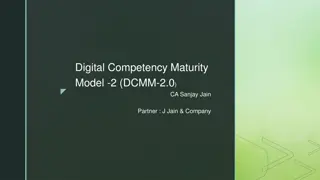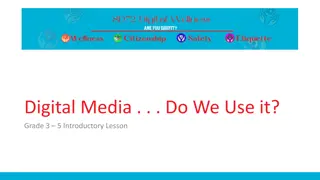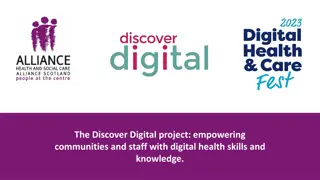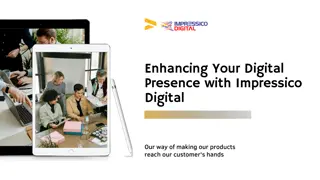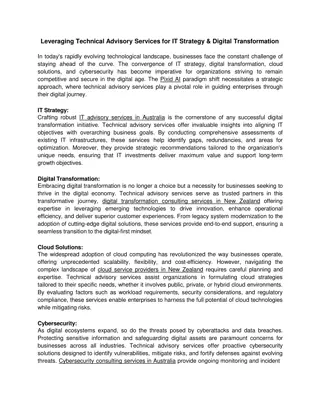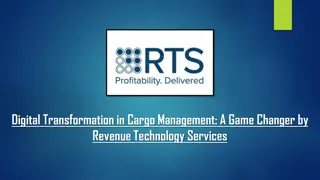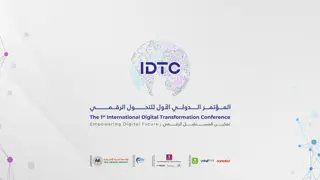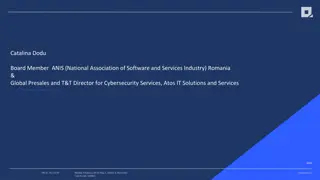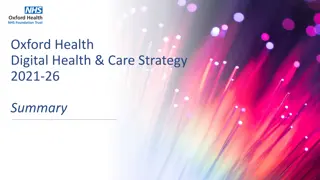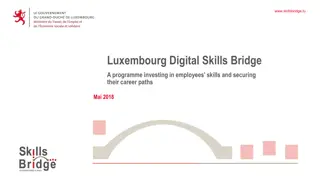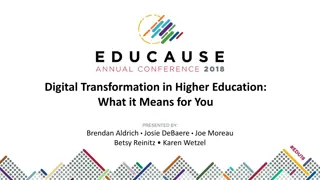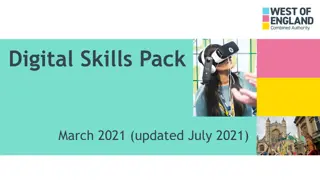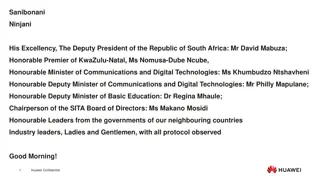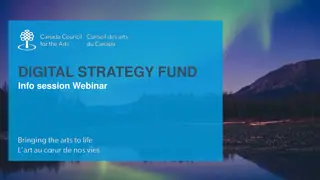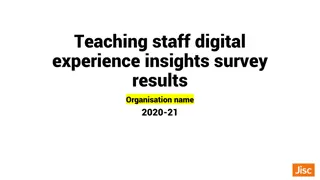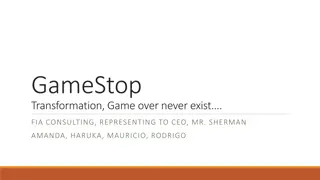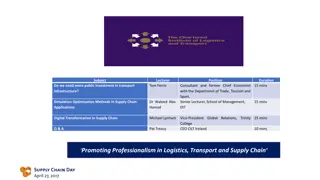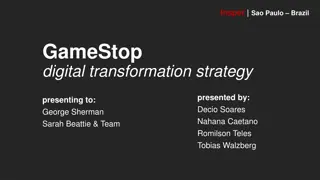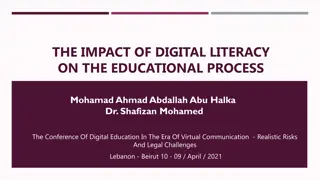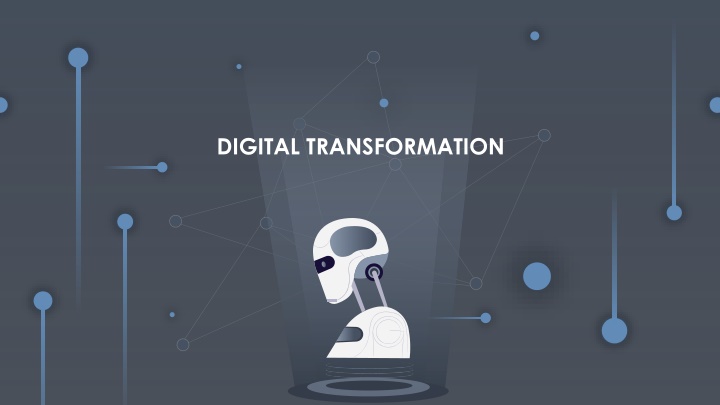
Embracing Digital Transformation for Business Growth
Companies are embracing digital transformation as technology shifts from enabler to driver. Opportunities lie in operational improvement and growth initiatives, driven by enhanced customer experience and key trends like IoT, social media, cybersecurity, mobility, big data, and cloud.
Download Presentation

Please find below an Image/Link to download the presentation.
The content on the website is provided AS IS for your information and personal use only. It may not be sold, licensed, or shared on other websites without obtaining consent from the author. If you encounter any issues during the download, it is possible that the publisher has removed the file from their server.
You are allowed to download the files provided on this website for personal or commercial use, subject to the condition that they are used lawfully. All files are the property of their respective owners.
The content on the website is provided AS IS for your information and personal use only. It may not be sold, licensed, or shared on other websites without obtaining consent from the author.
E N D
Presentation Transcript
Executive Summary Digital Transformation is being embraced by companies across most industries, as the role of technology shifts from being a business enabler to a business driver. Digital Transformation opportunities includes both Operational Improvement and Growth Driver initiatives, where the latter is driven largely by improved Customer Experience. Trends that drive transformation INTERNET OF THINGS SOCIAL MEDIA CYBERSECURITY MOBILITY BIG DATA CLOUD
Six Building Blocks of Digital Transformation Strategy and Innovation Focus on future value an drive fueled by experimentation Customer Decision Journey Deep analysis and ethnographic research to understand how and why customers make decisions Process Automation Reinvented processes and customer journeys through automation and agile processes Organization Agile, flexible, and collaborative processes and capabilities that follow strategy Technology 2-Speed IT to support core functions and rapid development Data Analytics Usable and relevant customer analytics tied to goals and strategies
Digital Transformation Capability Model Empower Your Employees Transform Your Products Optimize Your Operations Engage Your Customers Digital talent management Research and ideation Data-driven logistical planning Digital Advertising and CLM and development Product development Digital equipment management Customer data management Employee mobility Product launch Intelligent process Online and mobile commerce Productivity and collaboration Quality control management Tech enabled stores Tech-enabled employee Digitized front line and back Omni-channel experience engagement office operations Customer service automation
Digital Transformation Capability Model Transform Your Products Engage Your Customers Optimize Your Operations Empower Your Employees Research and ideation Digital Advertising and CLM Data-driven logistical planning Digital talent management Product development Customer data management Digital equipment management and development Online and mobile commerce Product launch Intelligent process Employee mobility Tech enabled stores Quality control management Productivity and collaboration Omni-channel experience Digitized front line and back Tech-enabled employee Customer service automation office operations engagement
Digital Transformation Capability Model Empower Your Employees Transform Your Products Engage Your Customers Optimize Your Operations Digital talent management Research and ideation Digital Advertising and CLM Data-driven logistical planning and development Product development Customer data management Digital equipment management Online and mobile commerce Employee mobility Product launch Intelligent process Productivity and collaboration Tech enabled stores Auality control management Tech-enabled employee Omni-channel experience Digitized front line and back engagement Customer service automation office operations
Digital Transformation Capability Model Empower Your Employees Optimize Your Operations Engage Your Customers Transform Your Products Digital talent management Digital Advertising and CLM Data-driven supply chain and Research and ideation and development Customer data management logistics Product development Online and mobile commerce Employee mobility Digital equipment management Product launch Productivity and collaboration Tech enabled stores Intelligent process and quality Tech-enabled employee Omni-channel experience control engagement Customer service automation Digitized front line and back office operations
Emerging Technology Trends Protection of information systems from theft or damage to the hardware, the software, and the information of our users. Connected devices of all kinds and cheap integrations everywhere create large amounts of data in need of effective management. The uninterrupted trend of using mobile devices impacts how people interact, use information, and how businesses reach them. SOCIAL MEDIA CLOUD BIG DATA INTERNET OF THINGS CYBER SECURITY MOBILITY Virtualize and consume infrastructure, platforms, and applications as a service (XaaS) enables better scalability and flexibility. Enable new ways and drive expectations of interaction, personalization, and building relationships within organization and with customers. Analytics and access to the right data enable new insights and decision-rich information, and allows us make use of such data.
Management: Board & Stakeholders New business models (content monetization) Distribution channels Strategic partners Talent management Changing user needs Unique content Licensing and rights management Contract management Regulatory compliance Security and fraud Data privacy Piracy Digital Transformation Growth & Operations Risk & Compliance Capability Model Content access/storage Technology platforms Changing technology Digital org. structure Digital business KPIs Cost of content Revenue recognition New processes and systems required Controls vs. performance Billing systems Capital spend Core Functions VALUE PRESERVATION
Levers to Digital Transformation DIGITAL TRANSFORMATION GROWTH DRIVERS OPERATIONAL IMPROVEMENT Demand Generation Reach & Selection Purchase Process Customer Experience Process Efficiency Asset Utilization New Business Models Agility Business Driver Levers Business Enabler Levers
Levers to Digital Transformation Examples GROWTH DRIVERS OPERATIONAL IMPROVEMENT DEMAND GENERATION REACH & SELECTION PURCHASE PROCESS CUSTOMER EXPERIENCE PROCESS EFFICIENCY ASSET UTILIZATION NEW BUSINESS MODELS AGILITY Brand awareness & brand interest through social media marketing Being where customers can easily find us Improved understanding of customer expectations via ongoing engagement with customer Clear, seamless, and secure ways to purchase Mobile payments Digitized and automated processes Optimized production/inventory planning Utilize remote access and collaboration & mobility tools for employees Analytics-based commercialization to target investments and track returns Improved process governance and efficiency through real-time insights Location based services Big data analytics to better understand purchasing behavior Data-based preventive asset maintenance Big data analytics to discover new customer segments Integration with partners in digital ecosystem to optimize service delivery Customer self-service Access to customers across multiple/all devices Social listening across all digital media channels XaaS opportunities to digitize tech Task automation
Growth Drivers channel interactions Real-time, omni- Customer Experience Matrix Targeted One-to-One The Customer Experience Matrix depicts 4 different kinds of Customer Experience, driven by varying degrees of capability INTERACTION CAPABILITIES in customer interaction and customer data access. INTERACTION CAPABILITIES measures how sophisticated, consistent, and Fragmented Mass targeted our customer touch points are. messaging One-way CUSTOMER DATA EFFECTIVENESS measures how connected our internal CUSTOMER DATA EFFECTIVENESS Disparate systems, Poor visibility Connected backend, Full & focused view of customer systems (storing customer data) are.
Shift in Customer Experience TRADITIONAL PROCESS MODERN PROCESS Evaluate Discover Consider Discover/ Evaluate Purchase Consider Purchase Use Experience In the modern view, the customer goes through a cyclical process, as she moves from Discover/Consider to Purchase and eventually back again. Each phase in the process represents a potential marketing battleground where companies compete for the customer s purchase and loyalty. This is a fundamental shift from the traditional view of sales, which is conceptualized linearly (with no feedback cycle component).
Social Media on Customer Decision Journey 3. AMPLIFY PHASES 2. RESPOND 4. LEAD 1. MONITOR Initial Brand Monitoring Crisis Referrals and Recommendations Brand Content Awareness Consideration Management Active Evaluation Product Launches Moment of Purchase Targeted Deals and Offers Post-Purchase Experien1ce Customer Service Fostering Communities Input from Customers Continuation of Evaluation Brand Advocacy
Customer Decision Journey Initial Consideration Set 1st Moment of Truth 2nd Moment of Truth A final shortlists based upon the evaluation phase. Products are viewed & reviewed either online or at shelf in-store, possibly both together. Consumer s carry preferences that often enable a rapid formation of an early consideration set for research and exploration, online, mobile, or in person. Unboxing and using our product. The consumer has new information for future brand purchases, as well as the ease and means to share those experiences, creating brand footprint. Zero Moment of Truth Purchase Decision Trigger The moment of purchase & associated experience is central to how our consumers feel about our brand before purchase takes place. Are they excited or impartial? A consumer s journey is emotional, triggered by need or want, influenced by direct and indirect brand messages, friends, WOM. It is not necessarily anything to do with brand owners or advert. Research sees brands added & subtracted to the early consideration set. Based on price, in- store browsing, social media, performance, and online reviews. Shared Opinions Positive & negative reviews become the next person s trigger McKinsey & Company Loyalty Loop
Customer Interaction Channel Map Initial Active Evaluation Moment of Purchase Post-purchase Experience Continuation of Evaluation Consideration Computer Mobile Social Retail In-Person Support Telephone Support MARKETING COMMERCE SALES SERVICE
Nonstop Customer Experience Model Customers now expect their experiences to be continuous, constant, customized, and cross-channel the key for us is to deliver a continuous customer experience. Discover Purchase Promises Delivery Evaluate Consider Use Open content and channels Branded content and channels
Operational Improvement Operational improvement can be achieved through new combinations of information, processes, channels, and workforce abilities that leverage new, high- performance business and operating models. Here are several such examples: PROCESS EFFICIENCY AGILITY Process optimization Adoption of Lean methodologies Reduction of manual effort Better businesses decisions with through automation NEW BUSINESS MODELS use of predictive analytics ASSET UTILIZATION Shift to self service Reduced production costs Automated lead nurturing Reduced inventory costs Agility
Process Automation STAGE 02 Monitor & relate production, distribution & shipment of products and services STAGE 04 Using different strategies and approaches to view the entire chain regularly. STAGE 05 Working efficiently at each and every step involved in the entire chain process. STAGE 03 Regular check-ins on internal inventories, productions, distributions & sales STAGE 01 Administrator schedules meeting for candidate to complete paperwork STAGE 06 Control the management flow of products & services, from product origin.
How can digital help me to Does our marketing strategy What new capabilities and improve financial performance? leverage opportunities of new organizational structures are technologies to improve our digital required to design and deliver consumer value proposition? new digital outcomes? Where is the profitability of our Critical Questions products/services threaten by Is there sufficient insights on how How does digitization help us digital e.g. new market entrants for Management users use digital technologies? attract and keep the best talent? with much lower costs structures? How does digital facilitate What will the future of work How to better control the customer retention? look like in our organization? business with real-time info? CDO CMO CHRO
Critical Questions for Management (Cont.) What should I do about digital How do I use digital to align the Where does IT help create new How can digital help me to disruptions in my industry? organization for increased speed business models & opportunities? improve financial performance? to market and more flexibility? How does digital help me grow Does the IT organization have the Where is the profitability of our the business, enter new markets capabilities to facilitate innovation products/services threaten by How to deploy digital solutions or strengthen the position? and enable the business strategy? digital e.g. new market entrants to improve process efficiency? with much lower costs structures? What areas does the company How does it threaten my value Does digital change the level of need to invest in in order to be chain ecosystem of customers, vertical and horizontal integration? How can we have more control ahead of the technology curve? suppliers, business partners? with real-time information? CEO COO CIO CFO
Digital Maturity Assessment Customer Experience Frequent errors & rebilling More complex rate structures leveraging interval usage data Interactive billing experience with usage alerts and recommendations Customized web- based bill views ACCOUNTING Monthly bill for simple rate structure Tailored rating packages ant automated alerts for better rate plans Improved accuracy and fewer errors and rebilling Inefficient credit & collections processes Multiple rating options Single or limited channel communication (i.e. mail and phone) Multi-channel communication (mail, phone, web) but siloed Implement an omni- channel, integrated customer engagement strategy Quickly integrate new communication channels ENGAGEMENT CUSTOMER Segmentation allows for customized experience for each customer Customer engagement is limited to monthly bill & reporting service issues Beginning to define an integrated customer engagement strategy 360o view of customer is universal Reacting to service issues Begin to define proactive organization of field resources to serve customers Priority-based appointment booking Right skills, right job, right time oriented access to the right resources and materials for each job DELIVERY SERVICE Customer appointments are based on utility availability, not customers Integration between supply chain and workflow for customer service issues SCORE 01 02 03 04
Digital Maturity Assessment Workplace Knowledge transfer is inefficient and costly, relying heavily on classroom training and experienced workers Some employee training is digitized and becomes more efficient Employee training is digitized and available on demand Employee training is pushed to individuals on-demand as part of continual improvement process EMPLOYEE TRAINING Knowledge transfer is shared digitally Knowledge send % best practices are captured & shared digitally Manual processes throughout the business lead to limitation of job Digital processes throughout the business drive need for expanded job knowledge Digital processes throughout the business enables expanded job knowledge Automated processes deliver on-demand job knowledge GENERAL BUSINESS PROCESSES Many issues are resolved with workarounds as temporary fixes Begin to identify and document key processes Algorithms are extensively used to optimize processes Automation begins to transform complex work processes No live access to customer information for field crews Mobile devices leveraged using store/forward sharing, and enable immediate answers for field crews Live access to all customer information for field crews Visual record of field work is standard FIELD WORK Simple digitization of some core field data for internal consumption only Field crews begin to leverage visual records for work Augmented reality makes remote work common SCORE 01 02 03 04
Digital Maturity Assessment Information & Technology Information silos Increasingly digital information tracking Information silos are actively broken down Digital information tracking and management relies on the Cloud INFORMATION Paper-based information tracking Invest in capturing data understand the importance in this, but still limited usage Digital info tracking is the norm and increasingly moves to Cloud All business decisions are driven by real-time data COMMUNICATION Back office-to-field communication (one-way) and worker-to-worker field communications Two-way communication flow between back office and field Integration allows fluid information flow between customer and meter, mobile, and outage systems Integration allows fluid information flow between all systems FLOW Increasing information flow between customer and meter systems (M2C) Very little information flow between systems Custom built systems and inefficient system integration; User experience influences ease of access to information Process standardization becomes priority and drives best-of-breed IT system selection; business owns IT purchase decisions Structure of systems and information is driven by job role IT SYSTEMS System structure restricts ease of access to info Cloud deployment begins for systems of innovation Cloud deployment expands to all systems SCORE 01 02 03 04
Score Results Interpretation 3-4 5-7 8-10 11-12 FRAGMENTED MODERN DIGITAL ACCELERATED Maturity classification: total combined score (across transformation areas) 9-13 14-22 21-31 31-36 LAGGARD ADOPTER INNOVATOR VISIONARY
01 02 03 04 Customer Experience Accounting Digital Maturity Of TOTAL 9 01 02 03 04 Customer Engagement 01 02 03 04 Service Delivery 01 02 03 04 Employee Training Digital Maturity Of Digital Maturity Operations TOTAL 8 01 02 03 04 General Business Processes Assessment Scoring 01 02 03 04 Field Work 01 02 03 04 Information Digital Maturity Of IT TOTAL 9 01 02 03 04 Communication Flow 01 02 03 04 IT Systems
Digital Maturity Model Improve Transform Automate STRATEGIC VALUE Optimize Align Radiate Initiate Crawl Walk Run DIGITAL MATURITY
Digital Maturity Levels TRANFORMED New approaches are INTEGRATED emerging through the digitization of core processes, Digital media is integrated products and services. New DEFINED more deeply into business control models are required. models where strategies Strategies are developed have been developed from pilot, project CONCEPTUAL and implemented experiences. A basic Digital transformation has awareness of digital change already been carried out with develops within company NO MATURITY certain projects, but no cross- Digital change has been departmental corporate discussed in some areas, strategy can be defined but there is still no implementation strategy
Execution Framework Overview STRATEGY CURRENT STATE FUTURE STATE ROADMAP IMPLEMENT MONITOR Change management & communication Governance evolution Program and project management / pmo
Execution Framework STRATEGY CURRENT STATE FUTURE STATE ROADMAP IMPLEMENT MONITOR Business change Project portfolio Target operation implementation Digital transformation model Transition to strategy Digital assessment steady state Technology change Requirements implementation management Channels Performance & Culture & people Architecture evolution stakeholder value change management People analytics Gap analysis and Ongoing Risk management prioritization maintenance Detailed implementation plan Process Business continuity Value assessment management Data and reporting Technology Launch, go live Continuous Digital maturity level improvement Initiatives integration Vision Service model Release management and prioritization GOVERNANCE EVOLUTION CHANGE MANAGEMENT & COMMUNICATION PROGRAM AND PROJECT MANAGEMENT / PMO
Six Layers of Successful Execution TARGET OPERATING MODEL LAYER How the Digital organization will be structured and fit into the rest of the organization.. Choose between centralized, decentralized, hybrid governance model. CHANNELS LAYER Determine the various digital channels to integrate into the Digital Strategy. Decide on specific channel selection and cross- channel integration/collaboration. PEOPLE LAYER Describes how the people are organized from both a geographic and business unit perspective, including lines of reporting and spans of control. PROCESS LAYER Outlines how specific process steps link to functions or departments that perform each step and accompanying policies/procedures to be followed when performing the process steps. TECHNOLOGY LAYER The applications that are used to enable the processes, policy compliance, internal controls, and generation of reports. SERVICE LAYER Describes how services are delivered. Includes Shared Service Center, Centers of Excellence, Business Partnering, Self Service, and outsourcing concepts.
End-to-End Work Streams Execution Effective Change Management is about Program Design and Governance is To ensure the success of a project, a getting people ready, willing, and able to the management framework within Project Management Office (PMO) deliver the sustainable business benefits. which project decisions are made. should be set up. Change Management plays a critical The role of project governance is to Many established structured approaches role in achieving organizational adoption provide a decision-making framework to project management have been that is logical and repeatable to developed, such as PRINCE2 framework. govern our capital investments. Communications is a key strategic lever to enhance awareness, buy-in, and ownership across our organization. CHANGE MANAGEMENT PROGRAM AND PROJECT GOVERNANCE AND COMMUNICATION MANAGEMENT / PMO EVOLUTION
IT Governance Model CORPORATE GOVERNANCE Set direction Align strategically IT GOVERNANCE IT Governance Objectives IT Governance Disciplines IT Governance Control Practices Governance body/ committee Governance initiatives and meetings Value Delivery IT strategy governance Architecture governance Strategic alignment Document controls and repositories Resource management Project & portfolio gov. Application lifecycle gov. Approvals and control checks Risk management Performance management Infrastructure and data gov. Vendor and sourcing gov. Service lifecycle gov. New age technology gov.
Your Text Here Additional Charts Option 2 Insert your text here Option 1 Insert your text here Value 01 Value 02
Your Text Here Additional Charts 8 8 8 8 6 6 6 6 4 4 4 4 2 2 2 2 0 0 0 0 2014 2015 2016 2017 2018 2014 2015 2016 2017 2018 2014 2015 2016 2017 2018 2014 2015 2016 2017 2018 5,500 7,000 5,500 7,000 Insert description or additional text here Insert description or additional text here Insert description or additional text here Insert description or additional text here
Your Text Here Additional Charts 6 7 6 5 5 4 43% 95% 4 3 3 2 2 1 1 0 0 Your Text Here Your Text Here Jan Feb Mar Apr May Jun Jul Aug Sep Data 1 Data 2 Data 3 Data 4 Your Text Here Your Text Here Your Text Here Insert additional text or your description for this chart here. Insert additional text or your description for this chart here. Insert additional text or your description for this chart here.
THANK YOU Questions?


